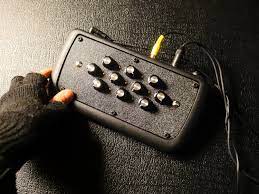What is a “glitch box” or “video glitch device,” and what is “circuit bending”?

A glitch box , or video glitch device (there is no official term; sometimes it is called a video synth, the next section explains how synths different than glitch boxes) , is a piece of hardware designed to intentionally introduce glitches, distortions, and artifacts into (usually analog) video signals. These devices are often used in creative and artistic contexts, such as video art, experimental filmmaking, or live visual performances. The goal is to manipulate and distort the video signal in unpredictable and visually interesting ways.
Glitch boxes typically work by modifying the electrical characteristics of older devices such as video enhancers, mixers, titlers, sketch pads, and more. The practice of modifying electrical circuits like this is called circuit bending . Circuit benders explore the electronic circuits within devices to identify points where modifications can be made. This usually involves adding switches, potentiometers (variable resistors), or other components to alter the behavior of the device so that you can create and control glitch effects. Circuit-bending a video device may introduce interference, voltage fluctuations, or other disruptions to a video signal - leading to various visual distortions such as color and light shifts, horizontal/vertical lines, rolling screens, stuttering images, pixelation, and other artifacts.
The exact nature of the glitches produced can vary depending on the specific device and its settings. And while many glitch boxes are simply older devices that have been circuit-bent, some glitch boxes are entirely new, handmade circuits.
Glitch boxes most commonly deal with composite video signals , meaning they have inputs and outputs that take a composite/RCA cable connection (remember those yellow, red, & white cables?). This is because composite video is analog, which in most glitch boxes maintains stability during glitching better than a digital video signal.
There are glitch devices that are not limited to composite signals. Some can process digital/HDMI video signals, and more of them seem to be introduced to the market each year. These digital devices produce visuals that are unique compared to analog glitch devices. Furthermore, you may come across different types of video signals connections as you build your video setup. See the “ Video Signals” and “Video Connections ” sections for more information.
A glitch box usually works best when outputting its video signal to a CRT television or monitor (those old bulky tube TVs). CRT TVs are (usually/largely) analog devices, so they handle signals “continuously”. This allows for more nuanced manipulation of the video signal, creating glitches that are often smoother and more visually interesting compared to digital displays. CRTs are also susceptible to analog signal degradation & electromagnetic interference, and this susceptibility can be intentionally exploited in glitch art. And of course, CRT TV’s have those infamous “scan lines”, where each video frame is composed of horizontal lines drawn sequentially. Glitch artists often manipulate these scan lines to create visual artifacts, distortions, and patterns. Much software is dedicated to replicating the analog nature and scan lines of CRT screens.
However, you can also skip TV’s entirely and simply record the output of your glitch box to your computer with one of those USB video capture cards that have a composite input. Keep in mind that capture cards are digital and often cannot handle extreme glitching, and the signal may drop.
As glitch boxes become increasingly sophisticated, many of them have impressive feature sets. A common feature is audio reactivity , meaning the glitch box can rhythmically sync its “glitching” to an incoming audio signal.
Another common feature is modularity, which in video circuits refers to the design philosophy where a video system is constructed using independent, interchangeable modules or components. Each module serves a specific function, and these modules can be combined, rearranged, or replaced to create a flexible and customizable video processing system. Some glitch boxes are semi-modular , meaning they have a certain number of connections built-in that can access different components of the circuit (using “ patch cables ”), but you can’t actually swap out modules/components. Other “glitch boxes” (and also video synthesizers - see next section) are actually just an arrangement of individual modules connected by patch cables. In terms of connectivity, modular video gear often follows a Eurorack format , similar to modular synthesizers used in audio production.